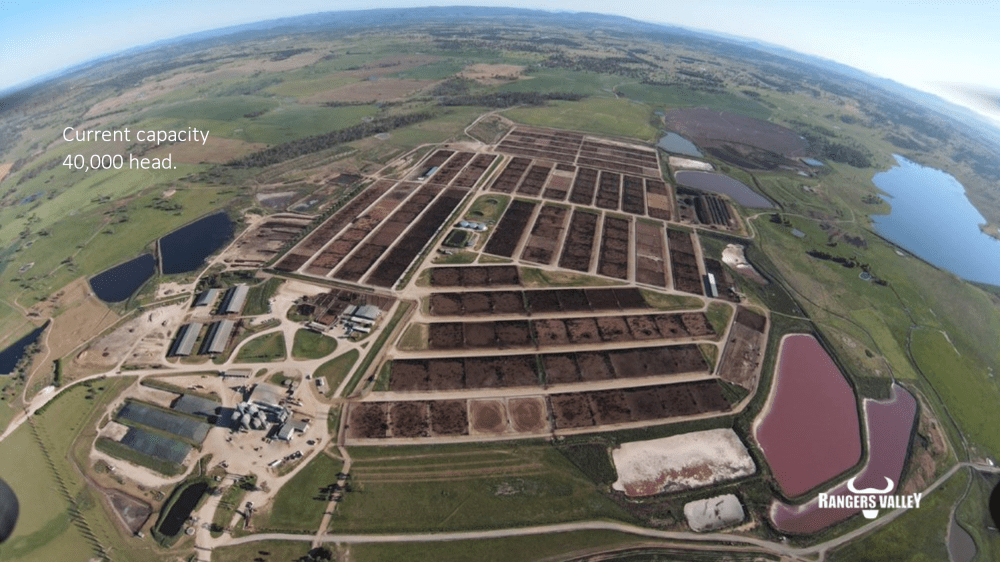Location: Rangers Valley feedlot, Glen Innes NSW
Capacity: 40,000 head
2015 Top 25 position: 6 (33,250 head); 2003 position: 12
FEW, if any, large-scale lotfeeding businesses worldwide have had the relentless, solitary, long-term focus on producing highly-marbled longfed beef as Rangers Valley near Glen Innes on the NSW New England Tablelands.
Since the yard started operations in 1988, it has focussed heavily on longfed 270-300 day Angus cattle designed to express optimum marbling. More recently, Wagyu cattle have been added to the programs, fed even longer.
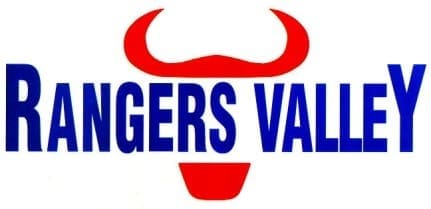
It can be argued that it is in its unique Angus longfed programs that the Rangers Valley brand has forged its strong international reputation over the past 30 years.
The business has been owned and developed by Japanese meat trading house Marubeni Corporation since 1988. The original business model was to provide premium grainfed beef into the company’s Japanese meat trading business, but over the past 15 years export markets have diversified dramatically, with the product now present in more than 50 markets around the world.
When Marubeni first bought the site, it operated a rudimentary feedlot with an operating capacity of just 4000 head.
But like most other yards on this Top 25 list, the facility has grown in stages over subsequent years and decades. By the time Malcolm Foster was appointed general manager in 1992 the picturesque Rangers Valley had grown to 12,000 head, around the time of beef market liberalisation in Japan.
Firstly under Malcolm’s stewardship, and from 2009 to 2016 by his successor, Don Mackay, the yard expanded further to 25,000 head, and then to 32,000 head.
Since Keith Howe took over as Rangers Valley managing director in 2017, the final expansion phase has taken capacity out to 40,000 head. The yard in fact holds a license for 50,000, but developing the final 10,000 would require considerable additional work, Beef Central was told.
That suggests Rangers may consider a ‘separate footprint’ for any further expansion in numbers on feed in company-owned facilities.
Having said that, Rangers also uses extensive custom-feeding resources in other yards – all owned by Australian Country Choice (yet to appear on this Top 25 list).
The majority of cattle on feed at ACC’s Brindley Park yard are now Rangers Valley owned. In total, ACC is currently custom feeding more than 14,000 head for Rangers, mostly Wagyu Purebreds to Fullbloods fed from 360-500 days, with the Rangers Valley yard itself now predominantly Angus cattle – mostly 270 days plus a few midfeds. All are HGP-free, in fact Rangers has never employed implants, conscious of optimising marbling performance.
Given the most recent expansion to 40,000 head at the Glen Innes yard completed in early 2021, it means Rangers currently controls around 54,000 head of longfed cattle at any given time.
Far from simply ‘adding additional pens’ the latest upgrade at the Rangers Valley site was a major undertaking, with almost half of the existing yard infrastructure re-built at the same time. Some of those pens had been in continuous use for more than 30 years. Other development work focussed on expanding and modernising water storage and delivery, and other contingencies.
Milling infrastructure was expanded earlier, around 2014.
Major shedding project
As explained in detail in a separate Top 25 article appearing today focussing on the grainfed industry’s recent heavy investment in shade and shedding structures, Rangers Valley is two weeks away from finishing a $3.1 million Entegra shed installation – believed to be the second largest in lotfeeding in Australia.
The new shed, some 440 metres long, will replace an existing smaller shedding structure that has been in place for years.
Rangers Valley’s location in a mild, low-humidity, elevated climate region has negated any need for shade installation, instead the company has moved directly into permanent shelter structures – but for reasons other than the simple shade and heat-load mitigation they provide.
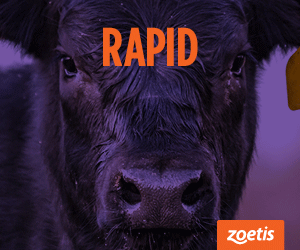 Experiencing long, cold, wet winters with little evaporation, the Glen Innes site will use permanent shed structure to mitigate feeding pen condition problems.
Experiencing long, cold, wet winters with little evaporation, the Glen Innes site will use permanent shed structure to mitigate feeding pen condition problems.
The covered areas will remain dry year-round, and be used for Angus longfed cattle for their final 100 days of a typical 270-day program.
“We’ve approached the shedding proposition from a whole different direction,” managing director Keith Howe told Beef Central. “For others, its mostly about heat load mitigation, but for us, it’s about improving pen conditions over our long, wet winters,” he said.
Rangers is working with MLA to carry out a research project around the installation, based on animal performance and carcase performance under-shed.
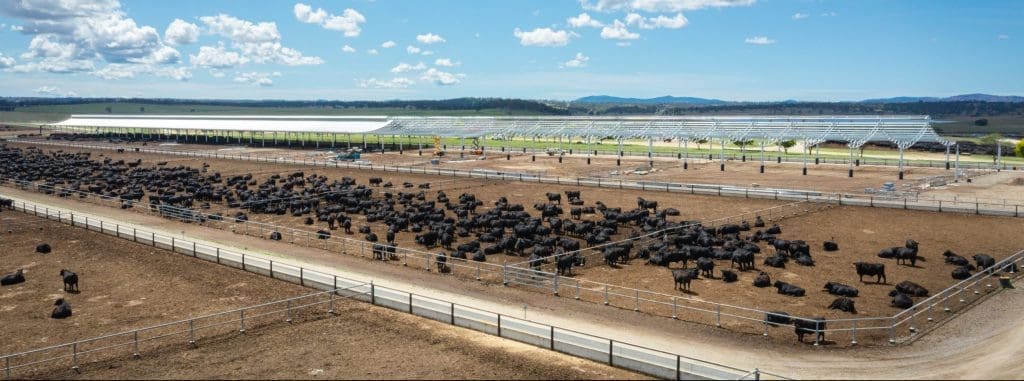
New shedding nearing completion at Rangers Valley. Click on image for a larger view. Click twice for an even closer view
Feeder cattle procurement, backgrounding
Given its sheer size, Rangers faces a significant feeder cattle procurement challenge each year.
Over time the company has built a strong network of engaged suppliers, ranging from high-performance F1 producers for F1 Wagyu programs, to large scale purebred Wagyu producers out of Queensland such as Hughes Pastoral Co, and some Fullbloods for a separate brand.
Midfed Angus is not a growing part of the business, but Mr Howe said it complemented the procurement strategy to ensure that the best cattle are sourced for longfed programs.
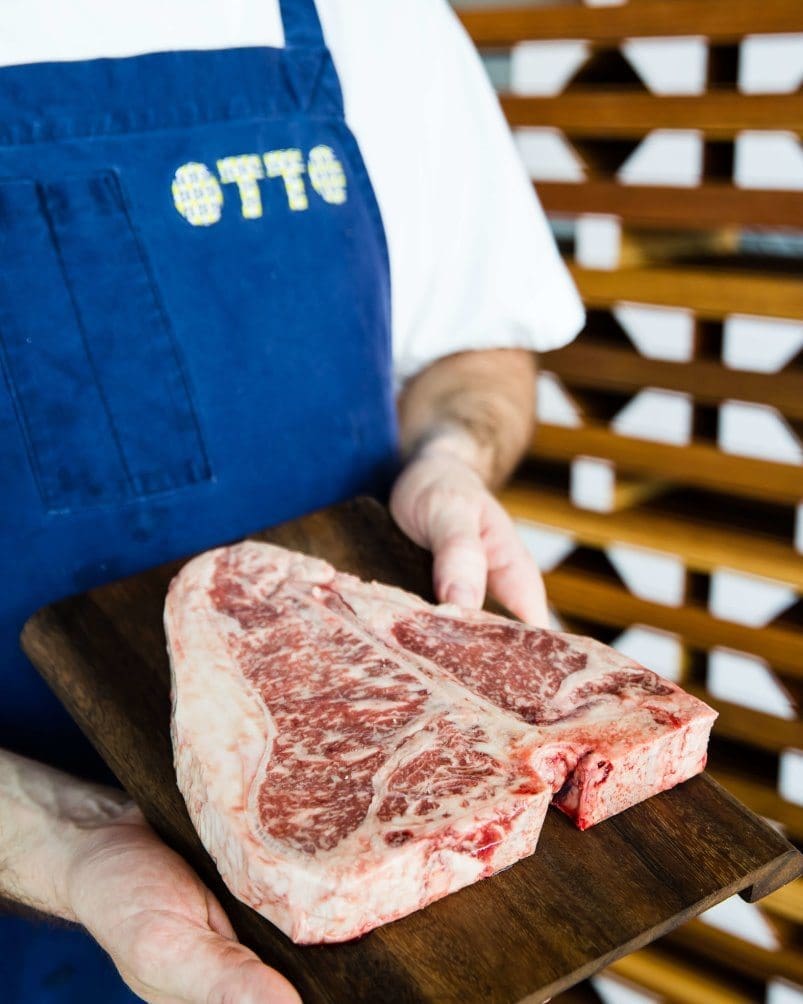
Highly marbled Rangers Valley Black Angus bistecca being prepared for service at Sydney’s Otto restaurant
“It’s such a huge investment to buy and feed these cattle, we cannot afford to have non-performers,” he said.
Prior meat quality performance is a key indicator when purchasing feeders, with Rangers holding carcase data records on some long-term cattle suppliers’ cattle extending back 20 and even 30 years. In fact Rangers would hold arguably more long-term performance data on longfed cattle than any other lotfeeder in Australia. It’s one of the key drivers behind a deep sense of feeder supplier loyalty.
Today, the expectation is for longfed Angus to hit marbling performance of 3-5, with a growing proportion higher than that. Carcase weights average 460kg, with Wagyu 440kg.
Around 10,000 head are routinely involved in backgrounding programs before entering the yards, either managed by Rangers Valley itself, or contracted out. A large Angus backgrounding program takes place in southern NSW involving around 5000 head, working with a large operator under a long-term arrangement.
Further backgrounding takes place on the New England, either at Rangers Valley itself, where up to 5000 young cattle are held, or on nearby properties.
Unique rations
One of the distinctions that sets Rangers apart from other large Australian lotfeeders carrying out longfed programs is its heavy reliance on locally-grown corn silage, used instead of sorghum or winter cereal silage. Areas on the New England are ideal for growing corn for silage and hay.
Corn silage is seen as a pivotal ingredient in the ration mix, with around 35,000 tonnes of high-protein, high-energy corn silage laid down in bunks at the yard each year.
“We are very particular in our ration ingredients, because making big changes in our ration mix can have big consequences in terms of cattle performance, marbling and even flavour profile,” Mr Howe said.
“Change something in the ration, and get it wrong, and it means we have a very large pipeline of very expensive cattle. We are very protective of any change in our ration formulation, and apart from fine-tuning additives based on solid science, it changes very little from season to season, or year to year, for that reason.”
Processing arrangements, beef brands
In parallel with its alignment with the ACC business in custom feeding, Rangers gets much of its processing for longfed Angus brand programs done at ACC’s Cannon Hill facility near Brisbane, which has changed direction since its Coles supplier days to become a major service kill provider. Some of the first trials of heavy carcase slaughter at Cannon Hill after the ACC/Coles relationship ended were Rangers cattle.
As numbers have grown, other cattle, mostly Wagyu, are also processed at Teys Beenleigh for China market access and John Dee near Warwick, where Ranger Valley cattle have been processed for 20 years. Both are in southern Queensland.
Beef brand programs are structured under Rangers Valley’s WX brands for F1 and purebred Wagyu, sold by marbling score range, with Fullbloods under the Infinite super-premium program. Longfed Angus are packed under the Black Onyx (MS 3-4), Black Market (MS5+) and Black Tie carton lids.
Staff levels
Rangers Valley’s latest jump in numbers on feed has required an increase in staff numbers to manage the cattle, with 65 personnel currently working on site. That number has grown by at least 20 since the earlier cycle.
Click here to return to Top 25 Lotfeeders table.
Click here to access all Top 25 Lotfeeders articles, as they appear in coming weeks
Feature proudly presented by Zoetis Australia and its products, BOVI-SHIELD MH-ONE, RHINOGARD and SYNOVEX


